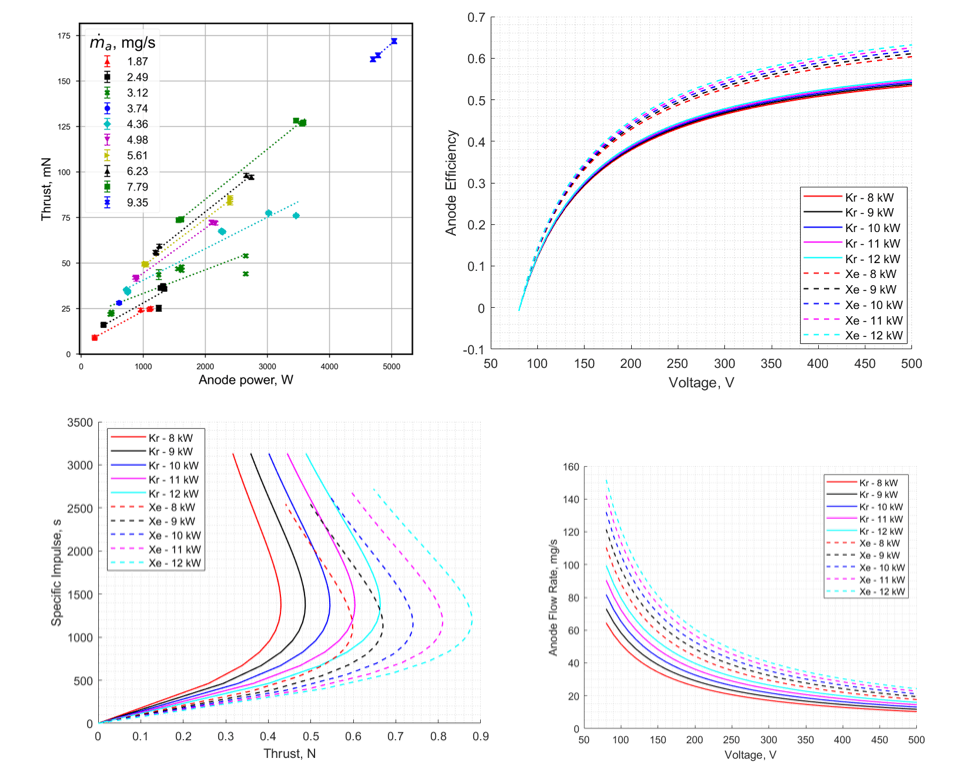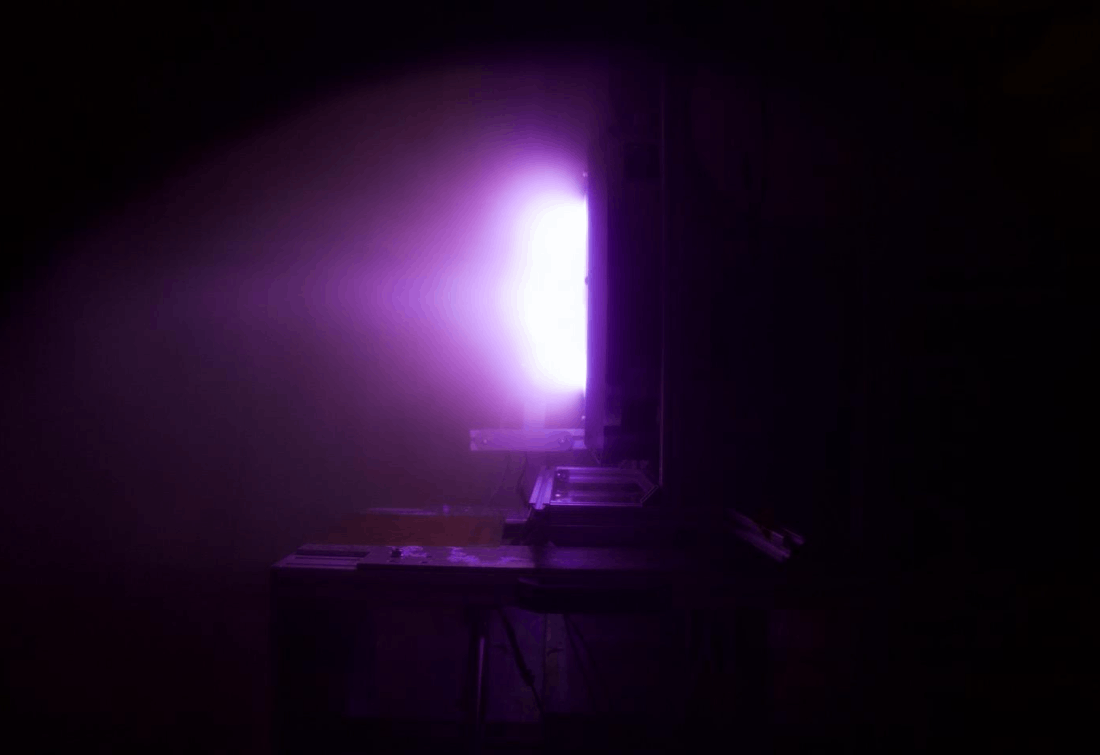Experimental Validation and Future Prospects
Author: Pulsar Fusion UK Ltd.
Pulsar Fusion, Bletchley, UK
Abstract
This paper presents the preliminary experimental results of a 10kW magnetically shielded Hall-effect thruster (HET) developed by Pulsar Fusion Ltd and tested in collaboration with Southampton University as part of the “Integrated Fusion-Based Power Systems for Electric Propulsion” project. The thruster, designed to operate with gaseous propellants such as Xenon (Xe) and Krypton (Kr), demonstrates promising performance metrics, including thrust up to 175 mN, specific impulse (Isp) exceeding 1875 s, and anode efficiency reaching 31.4% at 5kW power levels.
These results, obtained from rigorous testing conducted in January 2024, validate the thruster’s design and highlight its adaptability for low-cost propellants. Comparative analysis with design specifications and state-of-the-art systems underscores the thruster’s potential, with ongoing optimization poised to achieve the targeted 500 mN thrust and 50% efficiency at full 10kW operation. This work positions Pulsar Fusion as a leader in advancing electric propulsion for future deep-space missions, including crewed Mars exploration.
1. Introduction
Hall-effect thrusters (HETs) are a cornerstone of electric propulsion, offering high specific impulse and efficiency for space missions. Pulsar Fusion Ltd, in partnership with Southampton University, has developed a 10kW magnetically shielded HET as part of the “Integrated Fusion-Based Power Systems for Electric Propulsion” initiative. This thruster incorporates innovative features such as magnetic shielding for extended lifetime, a swappable anode for testing next-generation propellants, and a scalable design supporting up to 1 MW deployment. This paper reports on initial test results using Xe and Kr, showcasing Pulsar’s progress toward meeting ambitious performance requirements, including 500 mN thrust and 50% efficiency, essential for Mars missions.
2. Design Overview
The HET, detailed in the Critical Design Review (CDR) dated March 9, 2023, features a 300 mm diameter body with a magnetic circuit of AISI 1018 steel, an anode of Stainless Steel 310, and a Boron Nitride plasma channel. Magnetic shielding enhances longevity, while a swappable anode supports propellant versatility. The design targets 400-600 mN thrust and up to 65% efficiency, with operation in the 5-10 kW range, aligning with deep-space propulsion needs.
3. Experimental Methodology
Tests were conducted on January 26-28, 2024, using a dataset spanning 220 W to 5040 W anode power, voltages up to 250 V, and mass flow rates of 1.87-9.35 mg/s for Kr and Xe. Key metrics—thrust, Isp, and anode efficiency—were measured, with data validated against numerical simulations from the CDR. The thruster operated below its full 10kW capacity to assess initial performance, with plans for higher power testing.

4. Results
4.1 Thrust Performance
The thruster achieved a maximum thrust of 171.9 mN at 5040 W and 200 V with a 9.35 mg/s Kr flow, demonstrating robust performance at 5kW. Extrapolation from test trends suggests potential for exceeding 500 mN at 10kW, aligning with design goals and surpassing many contemporary 5kW HETs.
4.2 Specific Impulse
Isp reached 1875 s under optimal conditions, reflecting efficient ion acceleration. This value, competitive with existing 10kW HETs (1500-3000 s), indicates the thruster’s capability to support long-duration missions, with
further gains expected at higher voltages.
4.3 Anode Efficiency
Anode efficiency peaked at 31.4% at 200 V and 4-9 mg/s flow, a solid foundation for optimization. The CDR’s 65% target is within reach, as efficiency scales with power and voltage, areas of active refinement by Pulsar.
4.4 Propellant Versatility
Testing with both Xe and Kr showcased the swappable anode’s success. Kr delivered comparable performance to Xe at lower powers, offering a cost-effective alternative, a testament to Pulsar’s innovative design approach.

5. Discussion
The results highlight Pulsar’s HET as a promising advancement in electric propulsion. The 175 mN thrust at 5kW exceeds expectations for partial power operation, while the 1875 s Isp and 31.4% efficiency demonstrate a strong starting point. Compared to state-of-the-art 10kW HETs (e.g., Busek BHT-1000), which achieve 200-400 mN and 50-65% efficiency, Pulsar’s thruster is on an upward trajectory. The current underperformance relative to the 500 mN and 50% efficiency targets is attributed to testing at 5kW rather than 10kW, with voltage limited to 250 V versus the optimal 300-500 V range. Thermal modeling indicates manageable anode temperatures (max 1800°C), with mitigation strategies in development. Pulsar’s use of Kr alongside Xe positions the thruster as a leader in reducing propulsion costs, a critical factor for commercial spaceflight. The magnetic shielding and scalable design further enhance its suitability for Mars missions, with lifetime predictions under review.
6. Conclusion and Future Work
Pulsar Fusion’s 10kW HET demonstrates significant potential, with test results validating its design and adaptability. The achieved thrust, Isp, and efficiency at 5kW lay a solid foundation for meeting the 500 mN and 50% efficiency goals at full 10kW operation. Future tests will explore higher power levels (up to 10kW), voltages (300-500 V), and optimized mass flows (5-10 mg/s) to unlock peak performance. Thermal management enhancements and magnetic field tuning will ensure longevity, supporting Pulsar’s vision for fusion-powered deep-space propulsion.
Acknowledgments
The authors thank Southampton University for their collaboration and the Pulsar Fusion team for their technical expertise.
References
- CDR Document, Pulsar Fusion Ltd, March 9, 2023.
- Test Data, 10kW HET, January 2024.
- General HET Performance Data (e.g., Busek BHT-1000 specifications).
Pulsar Fusion Technical Report | Code: PF-MARSRANGER-KR-2024
